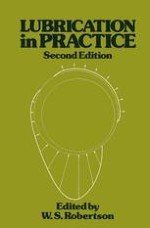1983 | OriginalPaper | Chapter
Cutting Oils
Authors : A. R. Lindsay, B.Sc., M.Inst.P., J. C. D. Russell
Published in: Lubrication in Practice
Publisher: Macmillan Education UK
Included in: Professional Book Archive
Activate our intelligent search to find suitable subject content or patents.
Select sections of text to find matching patents with Artificial Intelligence. powered by
Select sections of text to find additional relevant content using AI-assisted search. powered by
Although machining operations vary considerably, the basic process of metal removal remains the same. As the tool progresses through the workpiece, metal is compressed until it deforms plastically, that is, it begins to flow and form the chip that slides along the rake face, curls away and eventually breaks off (figure 12.1). A lot of heat is generated — 60 per cent in forming the chip, the remainder resulting from friction between tool, chip and workpiece (figure 12.2). Since the chip and cut surfaces are newly created they are ‘chemically’ clean and friction is high (see chapter 1). There is a strong tendency for the chip to weld to the tool; in fact small particles do weld together to form a built-up edge. Periodic breaking off of built-up edge mars the cut surface and abrades the tool.
